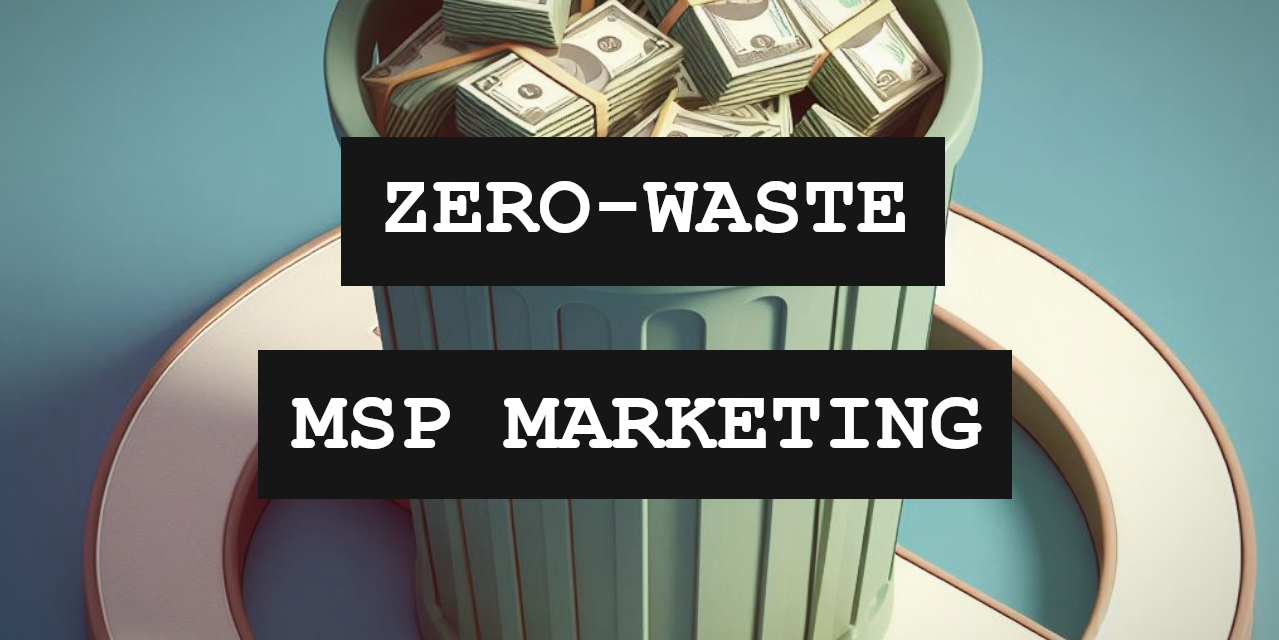If you are one of the MSPs that has worked with me over the years, then you already know that I am what many would call “frugal.” I don’t like to part with money if I don’t have to and I apply this same logic to every marketing project I take on. While marketing might seem like a frivolous luxury to most, it doesn’t have to be that way. You can take a practical approach that aims to reduce any and all excess, which I call the “zero-waste” method.
Over the years I have identified a few of the most common areas of waste that I have seen and created rules to avoid them. While this is not an exhaustive list per se, it is a great starting point to anyone wanting to get more for less when marketing their MSP.
Have A (Simple) Plan
One of the biggest contributors to waste in marketing is to spend money on campaigns without a plan. At the same time, the reason why most companies don’t have a plan is because of the flawed perception that this plan has to be thorough, detailed, and /or complex. If this is what is holding you back, I’m here to tell you that it’s time to move past all of this. A poorly documented plan is still better than no plan at all.
The most important part of a marketing plan is not necessarily the exhaustive details of how much you plan to spend and on what, it’s just to make sure that there is some kind of linear path between one activity and another. This is because even if these activities are successful on their own, the entire system breaks down when there are gaps in the process. To reduce waste, you must either find a way to fill these gaps and keep your funnel flowing through, or remove the activities that are siloed or inefficient. A plan simply forces you to identify and fix these problems.
The Ultimate Guide To Cash Flow For Managed Services
Sponsored by Alternative Payments & Zest
Bring Your Own Audience
Another misconception that I have noticed when talking to MSPs is that they believe that marketing has to be a high-volume endeavor. At one point, this might have been true, but that is no longer the case. As a matter of fact, campaigns with the most ROI are not those that generate the most impressions, but instead they are highly targeted to the right audience. This surgical-like precision is a great way to reduce waste in your ad spend.
The best way to achieve this is to prequalify your audiences. Essentially what this means is that you will create a list of all the companies that might be a fit based on your vertical or service area, and create a matched audience from this to serve your ads to. I recently wrote an article about this data collection process, as well as a tutorial for LinkedIn ads. Putting these two concepts together is a great start to launching a “BYOA” campaign.
Clarify Your Message
Success as it relates to marketing is often measured in actions. How many impressions did we generate? How many clicked through to our website ? How many of those visitors completed a form? Since we live and die by these metrics, it’s important to understand what causes your audience to take these actions and what does not. Most of the time I have found poorly performing ads, landing pages, and forms come down to a lack of clarity around who the content is actually for, what actions they should take, and how those actions will benefit the visitor.
In a nutshell, if you are speaking to everyone, you are essentially speaking to no one. There is simply too much noise out there for any remotely vague message to get through. Don’t be afraid to choose an audience (regardless of the size), speak to them directly, and tell them what to do next. If you are able to formulate a message with this level of clarity, while also getting that message in front of the right audience, you will produce results with little to no waste in the process.
Earn Your Media
There was once a time when earned media was difficult to achieve. This was largely due to gatekeepers in traditional media outlets (TV stations, newspapers, etc.) that dictated what was worth talking about and what was not. We are in an era now where everyone is “the media.” While it is still difficult to get massive amounts of media exposure at once, there is no shortage of completely free opportunities to reach small audiences with your message. I am talking about podcasts, blogs, events, social media, etc.
From my experience, earning these opportunities is all about hustle. You need to network your way through it, constantly connecting with people that influence your target audience. That could be highly respected peers in their industry, other vendors selling into that channel, local community leaders, etc. Once you get an opportunity to get in front of other people’s audiences, there is a snowball effect that often occurs, as other people see it and invite you onto their platforms. This compounding ROI on your time investment is what makes this a far better value than racking up ad-spend to broadcast your message.
The Ultimate Guide To Cash Flow For Managed Services
Sponsored by Alternative Payments & Zest
Repurpose Everything
I used to stick my nose up at the idea of reposting old content, or reformatting content for a different channel to keep it warm over a long period of time. There was always a paranoia that this would come off as lazy, and the audience would revolt, throwing tomatoes at their computer screens in disgust. Then one day I did it anyway and the only thing that happened was that more people saw the content than had previously.
This is why I now try to repurpose whatever I can, many times over. Not only can every event recording also be a blog article, newsletter, or social posts, but the highest performing pieces of content can also be turned into ads that cycle over longer periods of time. And as soon as you are confident that the audience has forgotten about it completely, you can dust it off and use it all over again. Taking this approach will allow you to produce way more with less investment, making it a key principle in zero-waste marketing.
Limit Tools & Services
I am going to start this paragraph by saying that I too have a marketing SaaS addiction. I don’t know what gets into me sometimes, but the second I see a tool that even remotely solves a problem or does a cool thing, I have to try it out. I have left a wake of free trials behind me, some of which have turned into paid subscriptions, while I was too busy testing the next thing to notice.
If this even sounds remotely familiar, then it might be time to double check your credit card statement. Chances are there is some waste that can be reduced by canceling subscriptions that are rarely used, or consolidating into tools that have more features. While I am usually against vendor consolidation altogether to avoid lock in, sometimes it makes sense when it comes to marketing tools that are only used on an occasional basis.
Expand Your Time Horizon
There are times when marketing looks like waste, but in reality the results have not had enough time to reveal themselves. In fact, you could argue that most marketing behaves this way. I have met a lot of MSP Owners over the years that struggle with this, as they hop from one thing to next, never really giving anything the time it needs to develop. This is understandable if you have a limited budget and you are trying to make something work on short notice, however you need to eventually settle on something and stick with it.
Expanding the overall time horizon that you use to measure success will help to avoid waste in the form of premature decision making. The best way to protect an investment in marketing is to actually spend enough money to see a return. This is especially true for MSPs, where the lifetime value of the customer is quite large and thus you can actually spend more than you think to acquire them. I understand that sometimes that one single click that generates a lead, who turns into a customer never comes, but this is the learning experience that you have to go through. If you never see it through to the end, then you will neither learn, nor grow.

SPONSORED BY ZEST

















